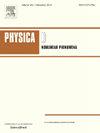光纤中的波湍流、热化和多模锁定
IF 2.7
3区 数学
Q1 MATHEMATICS, APPLIED
引用次数: 0
摘要
本文综述了近年来非线性多模光纤中复杂光传播现象的理论和实验研究进展。在波动湍流理论的基础上,导出了描述光学热化非平衡过程向瑞利-金斯(RJ)平衡分布的动力学方程。我们的理论被用于解释梯度折射率(GRIN)光纤中的光束自清洁(BSC)效应,即当输入峰值功率增大时,有斑点的光束在光纤输出处转变为钟形光束。虽然输出光束通常由光纤的基模主导,但高阶模(HOMs)不能完全耗尽,正如与守恒量相关的湍流级联所描述的那样。我们从理论上探讨了沿光纤芯的随机折射率波动的作用,并展示了这些缺陷如何在实际实验环境中帮助观察BSC。这一结论得到了波浪湍流动力学方程推导的支持,该方程解释了随时间变化的无序(随机模式耦合)的存在。动力学理论表明,弱无序加速了RJ热化和光束清洗冷凝的速度。另一方面,虽然强无序性有望抑制波动凝结,但动力学方程表明,在无序性超过非线性的情况下,可能会发生冷凝和RJ热化的非平衡过程。一般来说,动力学方程是通过对广义非线性薛定谔方程的数值模拟来验证的。我们概述了一系列最近的实验,这些实验允许确认描述光束传播和热化的统计力学方法。例如,我们强调了熵增长的演示,并指出在多模光纤激光器中存在固有的峰值功率缩放限制。最后,我们指出了实验观察,BSC伴随着模态锁相效应。这一方面解释了观察到的光束空间相干性的保留,但也指出了在未来的研究中需要扩展当前的描述。本文章由计算机程序翻译,如有差异,请以英文原文为准。
Wave turbulence, thermalization and multimode locking in optical fibers
We present a comprehensive overview of recent advances in theory and experiments on complex light propagation phenomena in nonlinear multimode fibers. On the basis of the wave turbulence theory, we derive kinetic equations describing the out-of-equilibrium process of optical thermalization toward the Rayleigh–Jeans (RJ) equilibrium distribution. Our theory is applied to explain the effect of beam self-cleaning (BSC) in graded-index (GRIN) fibers, whereby a speckled beam transforms into a bell-shaped beam at the fiber output as the input peak power grows larger. Although the output beam is typically dominated by the fundamental mode of the fiber, higher-order modes (HOMs) cannot be fully depleted, as described by the turbulence cascades associated to the conserved quantities. We theoretically explore the role of random refractive index fluctuations along the fiber core, and show how these imperfections may turn out to assist the observation of BSC in a practical experimental setting. This conclusion is supported by the derivation of wave turbulence kinetic equations that account for the presence of a time-dependent disorder (random mode coupling). The kinetic theory reveals that a weak disorder accelerates the rate of RJ thermalization and beam cleaning condensation. On the other hand, although strong disorder is expected to suppress wave condensation, the kinetic equation reveals that an out-of-equilibrium process of condensation and RJ thermalization can occur in a regime where disorder predominates over nonlinearity. In general, the kinetic equations are validated by numerical simulations of the generalized nonlinear Schrodinger equation. We outline a series of recent experiments, which permit to confirm the statistical mechanics approach for describing beam propagation and thermalization. For example, we highlight the demonstration of entropy growth, and point out that there are inherent limits to peak-power scaling in multimode fiber lasers. We conclude by pointing out the experimental observation that BSC is accompanied by an effect of modal phase-locking. From the one hand this explains the observed preservation of the spatial coherence of the beam, but also it points to the need of extending current descriptions in future research.
求助全文
通过发布文献求助,成功后即可免费获取论文全文。
去求助
来源期刊

Physica D: Nonlinear Phenomena
物理-物理:数学物理
CiteScore
7.30
自引率
7.50%
发文量
213
审稿时长
65 days
期刊介绍:
Physica D (Nonlinear Phenomena) publishes research and review articles reporting on experimental and theoretical works, techniques and ideas that advance the understanding of nonlinear phenomena. Topics encompass wave motion in physical, chemical and biological systems; physical or biological phenomena governed by nonlinear field equations, including hydrodynamics and turbulence; pattern formation and cooperative phenomena; instability, bifurcations, chaos, and space-time disorder; integrable/Hamiltonian systems; asymptotic analysis and, more generally, mathematical methods for nonlinear systems.
 求助内容:
求助内容: 应助结果提醒方式:
应助结果提醒方式:


